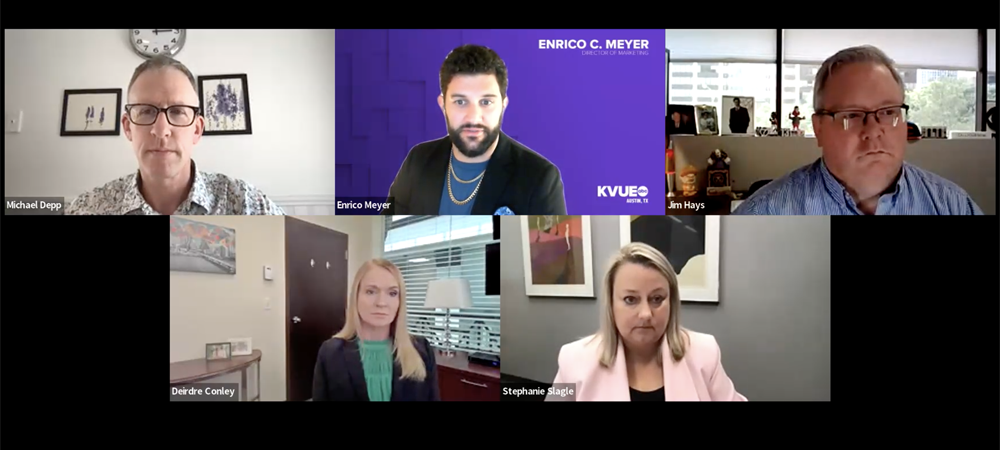
Local News Initiatives Pay Off In Spades, With The Right Megaphones

Look no further than Boomtown for an example of what happens when news stories examine the “raw nerves” that communities are concerned about — and when the journalism is amplified in effective ways by other members of a station’s team.
At Tegna’s KVUE Austin, Texas, the Boomtown news initiative tackles issues related to the market’s rapid population rise and the challenges that come with that, such as affordable housing. “While it’s definitely a success on our broadcast and linear platforms, on our digital products we have seen a tremendous response,” said Enrique Meyer, director of marketing at the station.
He noted that a typical KVUE news story on YouTube often pulls in between 200 and 400 views. However, Boomtown storytelling — with a strategic marketing push — can ramp up the YouTube numbers into the 30,000-50,000 range.
Those results were just one of many insights that came to light during TVNewsCheck’s webinar, Reinventing the Relationship with Local Audiences, held July 13. The session also featured Stephanie Slagle, VP and chief innovation officer at Graham Media Group; Deirdre Conley, creative services director at Cox’s WSOC Charlotte, N.C.; and Jim Hays, creative services director at Gray’s Cleveland duopoly of WOIO and WUAB. It was moderated by TVNewsCheck Editor Michael Depp.
Another compelling example is Get Real at WSOC. The recurring special reports have tackled topics like homelessness and affordable housing, along with mental health and race. According to Conley, the special on affordable housing in 2018 put the station in the No. 1 ratings spot in its timeslot. “It had over 17,000 impressions. The race special was also No. 1 in our key demo, adults 25-54, with over 23,000 viewers.” In comparison, she reported that the No. 2 station in the timeslot drew just over 18,000 viewers.
The reaction to Get Real hasn’t stopped there. When the specials air, viewers also call in to WSOC’s phone bank and thousands of people have picked up the digital resource guides that WSOC has created. That has made it clear that the station is “on the right path,” Conley said. “It’s something we want to stick to.”
Gray’s stations in Cleveland have deepened their local commitment to viewers in another way, through what’s known as the OTT Desk. In explaining the concept, Hays said that in the past, it wasn’t uncommon for WOIO and WUAB to cover a mayoral press conference (on such topics as a shortage of police officers) by simply streaming the event in a bare-bones style, without offering any added context.
“OTT Desk allows us to be more produced,” Hays said. “Instead of waiting for the mayor to come to the podium and do his thing, the anchor is talking about the facts — what’s going on, statistics that relate to the police shortage. They can also bring on guests.” OTT Desk anchors also wear some other hats: producer, director and reporter. Even adding supers and graphics is part of their duties. And the coverage can be edited into content for the regular newscasts, as well.
OTT Desk has also allowed Gray’s Cleveland Telemundo affiliate, WTCL, to go live with its evening news. That’s a big deal, because prior to using OTT Desk, the station recorded its 6 p.m. news at 2 p.m. “As everybody knows, four hours later is really not news,” Hays said. With the live approach, “it’s remarkable, to see how they put out a newscast. If you didn’t realize how they were doing it, you would have no idea it wasn’t going through a control room.”
At Graham, doubling down on local resulted in an initiative called Help Desk, which launched at WDIV Detroit and is now used by WSLS Roanoke, Va. As Slagle explained, it was funded by the Google News Initiative and built on the back of Zendesk, a help desk management solution.
Help Desk is a hub that allows anyone in a given market to reach out to the station and get support with certain challenges they’re facing. And that, in turn, gives the news departments a way to become more aware of what their viewers are facing and what they should address.
An offshoot of that are segments called “Help Me Hank,” featuring WDIV’s consumer reporter, Hank Winchester, who has been a “big driver for engagement,” Slagle said.
With Help Desk, the Graham stations want to own a one-to-one conversation with viewers—without relying on outside social platforms. “Our CEO, Catherine Badalamente, often says, ‘It’s not good to build your house on someone else’s land,’” Slagle said. “This is a much richer dialog because it’s happening directly with us. And that communication is something that we take very seriously.”
Graham intends to roll out Help Desk to all its stations by the end of this year. And while some staffers initially thought that it sounded time consuming, Slagle explained that the Help Desk system can actually reduce work. Chat bots make it easy to respond to viewers who are asking for information that others have already sought out — such as how to find someone to move an appliance. WDIV and WSLS have built up databases of answers to commonly asked questions that the bots can call upon.
All of the panelists stressed that in order to really move the needle with audiences, it’s critical for people working on marketing and promotions to build strong relationships with journalists in the newsroom. “You have to be visible in the newsroom all the time — not just send emails. Show your face and ask people what they’re working on. It all comes down to building trust,” said KVUE’s Meyer. “Then they will bring you in earlier.”
























Comments (0)